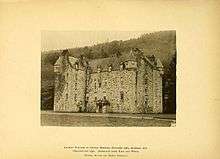Castle Menzies
Castle Menzies in Scotland is the ancestral seat of the Clan Menzies and the Menzies Baronets. It is located a little to the west of the small village of Weem, near Aberfeldy in the Highlands of Perthshire, close to the former site of Weem Castle, destroyed c. 1502.[1][2]


_-_geograph.org.uk_-_968718.jpg)
History
The sixteenth-century castle, built as a Z-plan castle,[3] was the seat of the chiefs of clan Menzies for over 500 years. Strategically situated, it was involved in the turbulent history of the highlands. In 1598 John Dow MacWilliam alias MacGregor broke into the castle to rescue a thief Donald Menzies from the dungeons. The owner, Alexander Menzies of Weem complained that John Murray of Tullibardine had then welcomed Donald Menzies and MacGregor as his household men and servants.[4]
Bonnie Prince Charlie, the Stuart pretender to the throne, rested for two nights in the castle on his way to the battle of Culloden in 1746. The restoration of the ancient part of the castle involved the demolition of a greatly decayed 18th century wing. A large Victorian ballroom (not visible in the adjacent photograph) was, however, retained.
The castle, restored by the Menzies Clan Society after 1957, is an example of architectural transition between an earlier tradition of rugged fortresses and a later one of lightly defensible 'châteaux'. The walls are of random rubble, originally harled (roughcast), but the quoins, turrets and door and window surrounds are of finely carved blue freestone. This attractive and extremely hard-weathering stone was also used for the architectural details and monuments at the nearby Old Kirk of Weem, which was built by the Menzies family and contains their monuments and funeral hatchments. A marriage stone above the original entrance was installed by James Menzies in 1571, to record his marriage to Barbara Stewart, daughter of the Earl of Atholl.[5]
Duleep Singh, last maharajah of the Sikh Empire, lived at Castle Menzies between 1855 and 1858, following his exile from the Punjab in 1854. He was officially the ward of Sir John Spencer Login and Lady Login, who leased the castle for him.
The castle was designated as a Category A listed building in 1971[6] and the grounds were added to the Inventory of Gardens and Designed Landscapes in Scotland in 1987.[7]
References
- File. Royal Commission on the Ancient and Historical Monuments of Scotland. Retrieved 7 December 2014.
- Logan, James. The Clans of the Scottish Highlands: Illustrated by Appropriate Figures, Displaying Their Dress, Tartans, Arms, Amorial Insignia and Social Occupations, p. 3. Ackerman. At Google Books. Retrieved 7 December 2014.
- «Saving and restoring Castle Menzies.» Official website. Retrieved 7 December 2014.
- David Masson, Register of the Privy Council of Scotland, vol. 5 (Edinburgh, 1882), p. 513.
- McKean (2001) p. 12
- Historic Environment Scotland. "CASTLE MENZIES (LB43568)". Retrieved 7 July 2020.
- Historic Environment Scotland. "CASTLE MENZIES (GDL00095)". Retrieved 7 July 2020.
Bibliography
- McKean, Charles (2001) The Scottish Chateau: the country house of Renaissance Scotland. Stroud: Sutton Publishing ISBN 0-7509-2323-7; p12
External links
- http://www.castlemenzies.org The Official Castle Menzies Website
- Map sources for Castle Menzies